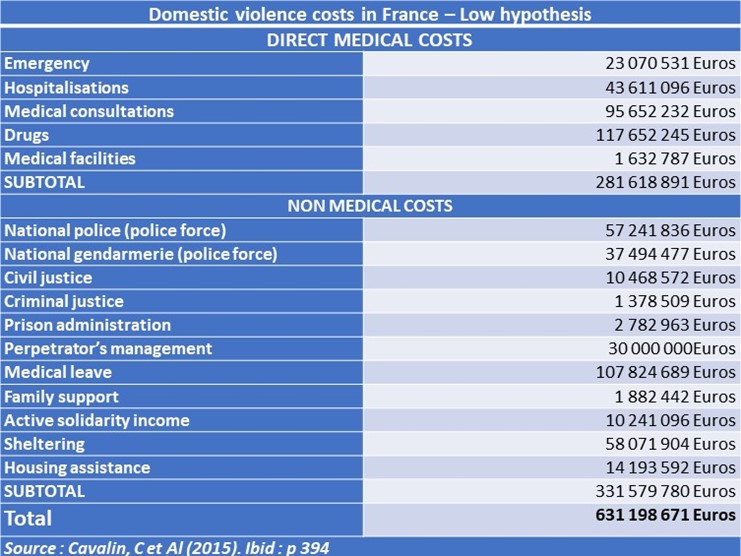1. Prevalence data and victim surveys
2. Costs of domestic violence
3. Age distribution of domestic violence
4. Number of deaths
1. Prevalence data and victim surveys
In France in 2022, the security services recorded 244,000 victims of violence committed by their partner or ex-partner, representing an increase of 15% compared with 2021, close to the average annual growth rate recorded since 2019. The number of victims recorded has doubled since 2016, as the police and gendarmerie have freed up the victims to speak out and improved the conditions in which they are received. The proportion of victims reporting incidents prior to their year of registration remains stable compared with 2021 (28%).
Two-thirds of domestic violence cases involve physical violence; the vast majority of victims are women (86%), while the accused are more often men (87%). As in 2021, Seine-Saint-Denis, Guyane, Pas-de-Calais, Nord and Réunion are the départements with the highest rate of recorded victims per 1,000 inhabitants aged 15 to 64.

The SSMSI is the official statistics website of the French Ministry of the Interior.
In addition, the results of the Genese 2021 victimisation survey show that only one in 4 victims of domestic violence reports the incident to the security services.
In 2021, 3.6 million women aged between 18 and 74 – 15.9% of women in this age group – said they had experienced physical or sexual violence by a partner at least once since the age of 15.

2. Costs of domestic violence
According to an estimate carried out in 2018, the financial needs in terms of combating domestic violence are estimated at between EUR 506.1 million and EUR 1 106.3 million. This estimate concerns only women victims of such violence. With the 4th inter-ministerial plan to combat violence against women (2014-2016), a study on estimating the economic costs of domestic violence has been carried out. Based on 2012 data, the direct annual cost of supporting women victims of domestic violence is 631.2 million euros. These costs in 2012 are allocated as follows:

There are very few recent financial studies on the costs generated by domestic violence.
However, it may be useful to quote the study published in March 2022 in French by the Fondation des Femmes – the women’s foundation (https://fondationdesfemmes.org/fondation/nos-publications/) entitled “Le coût des inégalités en France” (The cost of inequalities in France), which estimates the annual cost of domestic violence at 3.3 billion euros.
3. Age distribution of domestic violence

The SSMSI is the official statistics website of the French Ministry of the Interior.
4. Number of deaths
- In 2022, 145 violent deaths within couples were recorded by the police and gendarmerie units, compared with 143 the previous year (2 more victims, or +1%).
- These incidents represent 18% (19% in 2021) of all non-criminal homicides and intentional violence resulting in death without intent to kill recorded in France in 2022 (818 cases recorded).
- On average, one death is recorded every two ½ days, a figure that is stable compared with 2021.
- 366 attempted homicides within a couple were recorded out of a total of 3,486 attempted homicides. This represents 10% of all attempted homicides.
- 64 of the 107 overseas departments and collectivities (60%) recorded at least one death.
- The departments recording the most deaths were Nord (7 female victims and 2 male victims), Alpes-Maritimes and Rhône (both 5 female victims), then Seine Saint Denis (4 female victims and 1 male victim).
- In the French overseas departments and territories (DROM/COM), Guyana, Réunion (2 female victims and 1 male victim each) and New Caledonia (3 female victims).
- As in previous years, women are the main victims: 118 in 2022 compared with 122 in 2021 (4 fewer victims, i.e. -3%). They represent 81% of all victims. (-4% compared with 2021).
- In 2022, the number of male victims will be 27, compared with 21 in 2021 (6 more victims, i.e. +29%).
- The typical profile of the perpetrator has not changed. They are predominantly male, most often in a relationship, of French nationality, aged between 30 and 49 and not in employment or no longer in employment.
- Arguments and refusal to separate remain the main motives for committing the offence.
- Most of the crimes are committed in the couple’s home, by the victim or the perpetrator, without premeditation, mainly with a knife or a firearm.
- The typical victim is predominantly female, most often of French nationality, aged between 30 and 49 and not or no longer in employment.
- 14% of perpetrators and 12% of victims were aged 70 or over at the time of the crime. This compares with 25% and 20% respectively in 2021. 9% of perpetrators and 6% of victims were aged 80 or over. Illness or old age is the main reason why these elderly people commit crimes.
- In 36% of cases, the presence of at least one substance likely to impair the discernment of the perpetrator and/or the victim (alcohol, narcotics, psychotropic drugs) was observed at the time of the offence.
- 31% of female victims had already been subjected to violence. 65% of them had reported the previous violence to the internal security forces, and 79% of them had lodged a complaint. Only two perpetrators were under judicial supervision and one victim had been issued with a serious danger telephone. One male victim was the subject of a protection order.
- As in 2021, 12 minors died within the family, victims of infanticide.
Deaths in couples: 2006/2022 evolution

Red = Men
According to a study by the French Ministry of the Interior: “Violent deaths within couples in 2022”
